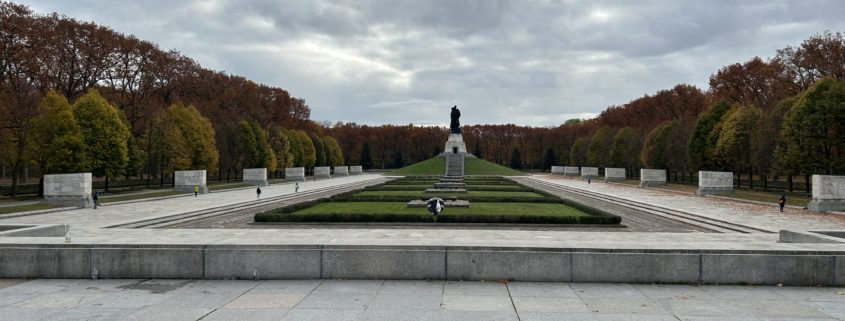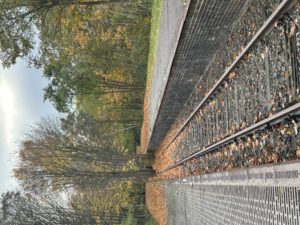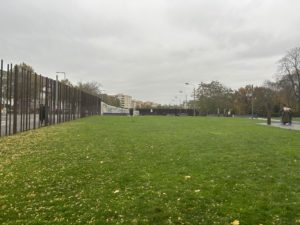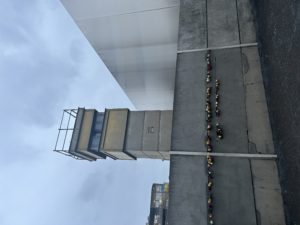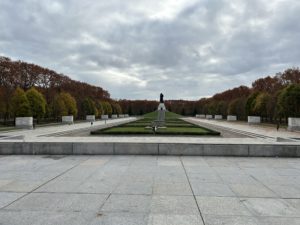Nature Is the Strongest Healing Force
By Kennedy Snyder
Throughout our travels and studies, we have visited many memorials and heard about all different kinds of atrocities. At every memorial, we walk in with solemn minds full of thoughts about those whose lives were lost, and reason behind the memorial. We read the list of names, or look at the art that surrounds the memorial, we read the dates, thinking back to all of our history lessons, and try to figure out where we go from there, in our daily lives, but also as a people. However, at every memorial, we are always surrounded and supported by different types of nature, by big trees lining the perimeter, by soft grass placed in the center of the memorial, and by different kinds of plants and flowers. In Berlin, specifically, there was three different memorials that we visited, the Track 17 Memorial, the Soviet War Memorial at Treptower Park, and the Berlin Wall Memorial. In all of these public spcaes of remembrance,, we saw forms of nature surrounding the areas. The nature at these memorials reminds us that we can live through this just as nature lives through every storm and tragic event, it reminds us that we are not alone, and that we as a species are connected to each other, that every tragedy we share.
Track 17 is a memorial at Grunewald Station, dedicated to the memory of those who were stolen during the night and murdered, as well as about keeping the promise they made in 1988. Track 17l was built in 1988, the building plans were initiated by the Deutsche Bahn, the German national railway company. The very same company who was responsible for creating the railways which were used to transport the innocent souls to their deaths at both the concentration and death camps (source 2). The Deutsche Bahn was the national transportation company that was responsible for a large part in the murder of innocent souls. Without their trains there wouldn’t have been an way to eficeitnly transport thousands of people at a time, with that responsiblitity known, it only makes sense that they would need to take part in attempting to rectify those loses. They cut the tracks on the end facing the station and instead planted trees. The trees act as physical forms of protection, with those trees where they are there is no way another train could ever use those tracks even if they wanted too. When we went there were flowers placed on most of the plaques on the platforms which represented each time the trains left the station, how many people they took, and where the train was going. The memorial was one of the only ones that seemed in a way peaceful, it was a smaller area, so the trees seemed bigger and made the area more confined, and even the wooden part of the tracks had plants growing through cracks and moss growing on the surface. When seeing that all I could think of was the fact that the space was healing, and that hopefully those who died there, found some peace of their own, knowing that that train station would never forget, and that nature was creating life in the place that initially stole theirs.
We have spent time visiting and studying many memorials, and yet during the short time of my semester, I was inspired by the fact that even with dark history, humanity still finds a way to survive. On our first day in Berlin we visited the Berlin Wall Memorial. This memorial began in 1990 when the east erlin magistrate placed a section of the wall under “monument protection”, from there there was consistent effort to create a memorial that would honor and remember the victiums who died trying to escape to freedom. In 1998 the memorial was officially complete and tells the story of life in east berlin, and the honors the dead who only wanted to be free ( source 4). The memorial was constructed keeping importance on the preservation of the structure form the wall that still stood standing. The Berlin Wall was not just a single wall made of cement, on the East Berlin side, as it was on the West, it was but rather a complex system of infrastructure and security meant to keep the citizens inside. There was the main section of the wall, the front which was shared with West Berlin, and then there was what was called “no mans land” which ended up being a sand pit equipped with watchtowers and security patorols, and then the back wall which the citizens of East Berlin were not allowed to go near. This memorial had similar features of other memorials but also looked different than any other memorial that I had seen before. We visited the memorial on the annivaersay of the Berlin Wall falling, so there were wreaths and white roses that were placed on the main focal point of the memorial. When you first cross through the damaged wall, it looks almost like a park, equipped with grass, pathways, trees and people moving around inside it. As far as memorials go, there was a structure that had the names and pictures of those who had died, there ended up being 141 deaths that we know of at the time, there are still more people that could’ve lost their lives due to the violence led by the East German forces. At every picture, there was a white rose, a way of showing to those who lost their lives that they are remembered. In the back of the memorial, the part that cant really be seen from the memorial structure with the pictures and names, there was a watchtower and part of back wall still standing. In that wall there was roses filling the cracks showing respect and remembrance for the many lives that were lost there. The flowers almost look like they’re growing out of the wall, like they’re surviving in spite of the stone wall. As our guide was leading us through this memorial, she said that where we were standing behind the Wall of Berlin, and in front of the back wall (where the memorial is) was all sand. The sand was there as a way of the soldiers trying to do everything in their power to keep East German citizens from escaping to West Germany. However, the sand was taken away after the wall came down, grass was able to grow, and the area that was once illegal to even stand on, is now a sort of park, a place of knowledge and remembrance, and finally, a place of the public, where anyone can go at any time. The memorial realized the inaccessibolty of the area known as “ no mans land” and instead took away the sand, planted grass, and made it a place of accessibility and of remembrance.
When we visited Berlin, we saw the Soviet War memorial, this memorial was built beginning in 1946, and finished in 1949, four years after the second war had ended. This memorial was created as a way to honor the 80,000 soldiers that had died during the second World War, when they were fighting with the goal of occupying and controlling Berlin. Treptow Park is where the memorial stands, safely protected from the bustling city all around it, it is the biggest memorial in Germany ( source 3). Treptow was surrounded by trees, everywhere you looked you would see trees. There were two different types, the first being weeping birches, and the second being big, tall sycamore trees. The weeping birches symbolized the pain and sorrow that the 7,000 soldiers that are buried there felt, but also the tragedy that shook the entire motherland. The birches where placed all along the path that leads up to the the beginning of the infrasturure part of the memorial, as well as the statues of grieving soldiers.
The sycamore trees were planted all along the outside of the memorial, except for the entrances which are grand stone arches. These trees act as if they are not only a shield but a wall that separates the memorial from the rest of the city. They almost seem to be standing on guard, guarding the memory of the soldiers, and the power that the soviet army once had. Nature plays a very important role, it portrays the emotions that all of Germany felt, and it guards those who were laid to rest there. The nature at Treptow Park is a type of protection, but also meant to serve as a form of comfort for all those who seek out this memorial, the trees are a way or promising all those who mourn that those whos lives were lost will not be forgotten. Soviet War Memorial at Treptow Park, picture taken by myself
At all of these memorials, the placement of nature was intentional, and the kind of plants and trees that were placed, was even more so, nature aids the internationally shared society in the process of healing form these tragedies. Nature plays an important role at memorials specifically; it allows the peace of life to begin to heal the pain of so many deaths. It allows reminds us that the world is connected, that we as humans owe it to each other to shield like the trees, to want life in such a way that we grow through barriers, like when plants force themselves through cracks of wood or rock. Nature shows us the power of life, and of growth, and that that power will always be stronger than death and despair.
Bibliography
- Davies, D. (2022, December 1). MONUMENTS TO THE UNTHINKABLE. NPR. https://www.npr.org/2022/12/01/1140069226/monuments-to-the-unthinkable-exploreshow-nations-can-memorialize-their-atrocities
- Seemann, U. (n.d.). Informational Portal to European Sites of Remembrance. Information Portal to european sites of remembrance. https://www.memorialmuseums.org/eng/staettens/view/338/Mahnmal-Gleis-17%E2%80%93–Berlin-Grunewald
- Soviet memorial treptow. visitBerlin.de. (n.d.). https://www.visitberlin.de/en/sovietmemorial-treptow
- The Berlin Wall Memorial. Berlin Wall Foundation. (n.d.). https://www.stiftung-berliner-mauer.de/en/berlin-wall-memorial/historical-site/memorial

